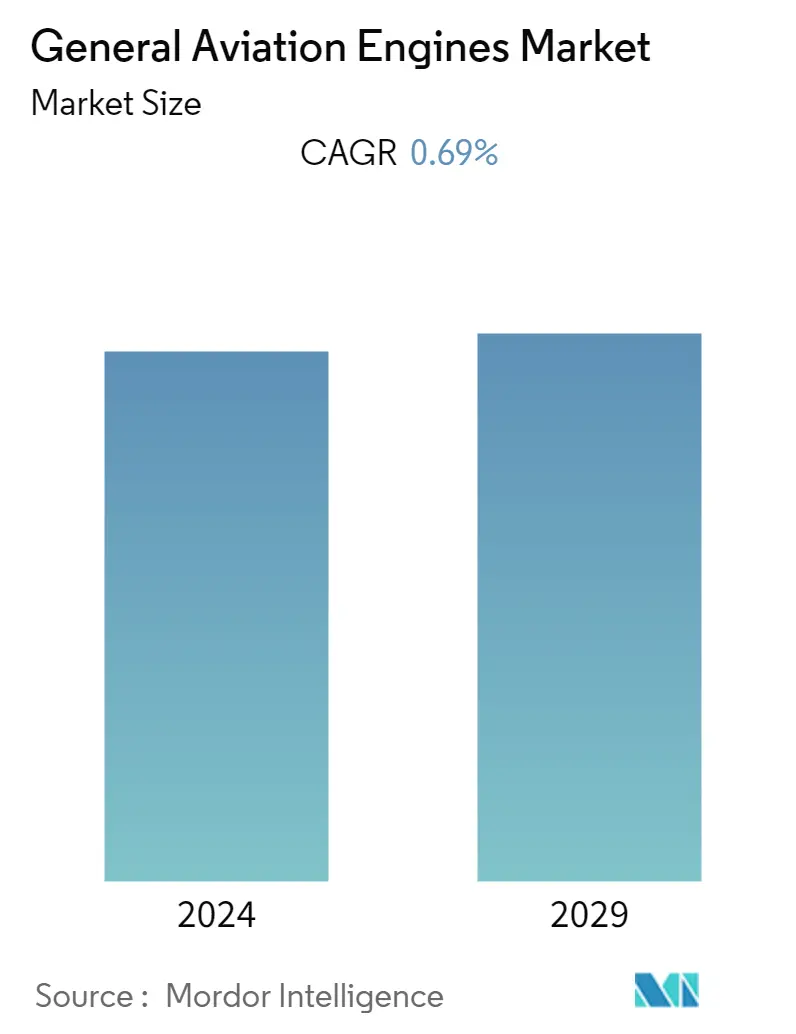Market Size of General Aviation Engines Industry

| Study Period | 2019 - 2029 |
| Base Year For Estimation | 2023 |
| CAGR | 0.69 % |
| Fastest Growing Market | Asia Pacific |
| Largest Market | North America |
| Market Concentration | High |
Major Players
*Disclaimer: Major Players sorted in no particular order |
General Aviation Engines Market Analysis
The general aviation engines market is anticipated to increase from USD 5.57 billion in 2022 to USD 5.71 billion in 2028, registering a CAGR of 0.69% during the forecast period.
- The market of general aviation engines was highly affected by the COVID-19 pandemic due to a downturn in the aviation industry, which resulted in reduced deliveries of general aviation engines in 2020 and 2021. However, the large-scale backlog of aircraft original equipment manufacturers (OEMs) in the general aviation sector is expected to drive the market during the forecast period.
- The general aviation market experienced steady growth in 2022 compared to 2021. The reason for this growth was the increase in deliveries of business jets and piston-engine aircraft. The global rotorcraft fleet also experienced a growth of over 8.5% in 2022. The necessity to reduce aviation emissions is fueling the development of fuel-efficient and lightweight engines.
- One such technology is hybrid engines for aircraft that will witness growth during the forecast period. Prominent players such as Safran and Rolls Royce have already unveiled their hybrid engine prototypes and are significantly investing in this technology. Such advancements will support the growth of the market during the forecast period.
General Aviation Engines Industry Segmentation
An aircraft engine is a component of the aircraft's advanced propulsion system that generates mechanical power. The aftermarket sales of the engine and its parts and sales of auxiliary power units (APUs) are excluded from the study.
The general aviation engine market is segmented by engine type and geography. Based on the engine type, the market is segmented into fixed-wing aircraft engine and rotorcraft engine. Based on geography, the market is segmented into North America, Europe, Asia Pacific, Latin America, and the Middle East and Africa.
The market sizing and forecasts have been provided in value (USD billion).
| Aircraft Engine Type | |||||
| |||||
|
| Geography | |||||||
| |||||||
| |||||||
| |||||||
| |||||||
|
General Aviation Engines Market Size Summary
The general aviation engines market is poised for growth, driven by a resurgence in air travel and advancements in engine technology. The market, which faced challenges due to the COVID-19 pandemic, is expected to recover as aircraft original equipment manufacturers clear their backlogs. The sector saw a steady increase in 2022, with a rise in deliveries of business jets and piston-engine aircraft, alongside a growing rotorcraft fleet. The push for reduced aviation emissions is spurring the development of fuel-efficient and lightweight engines, including hybrid technologies, which are gaining traction with significant investments from industry leaders like Safran and Rolls Royce. This technological progress is anticipated to bolster market expansion over the forecast period.
Globally, the market is experiencing growth due to increased leisure and business air travel, rising disposable incomes, and the development of aviation infrastructure. Turbofan engines are expected to lead the growth trajectory, supported by investments aimed at expanding the general aviation fleet. The Asia-Pacific region is projected to witness the highest growth, with countries like China, India, and Japan contributing significantly through new aircraft orders and deliveries. The region's market expansion is further fueled by developments in airport infrastructure and increased demand for various aviation services. The market is moderately consolidated, with major players like Rolls-Royce, Safran, and General Electric holding significant shares, and ongoing investments in research and development are expected to meet the demand for low-emission, high-efficiency engines.
General Aviation Engines Market Size - Table of Contents
-
1. MARKET DYNAMICS
-
1.1 Market Overview
-
1.2 Market Drivers
-
1.3 Market Restraints
-
1.4 Porter's Five Forces Analysis
-
1.4.1 Threat of New Entrants
-
1.4.2 Bargaining Power of Buyers/Consumers
-
1.4.3 Bargaining Power of Suppliers
-
1.4.4 Threat of Substitute Products
-
1.4.5 Intensity of Competitive Rivalry
-
-
-
2. MARKET SEGMENTATION
-
2.1 Aircraft Engine Type
-
2.1.1 Fixed-wing Aircraft Engine
-
2.1.1.1 Turbofan
-
2.1.1.2 Turboprop
-
2.1.1.3 Piston
-
-
2.1.2 Rotorcraft Engine
-
2.1.2.1 Turbine
-
2.1.2.2 Piston
-
-
-
2.2 Geography
-
2.2.1 North America
-
2.2.1.1 United States
-
2.2.1.2 Canada
-
-
2.2.2 Europe
-
2.2.2.1 United Kingdom
-
2.2.2.2 France
-
2.2.2.3 Germany
-
2.2.2.4 Italy
-
2.2.2.5 Rest of Europe
-
-
2.2.3 Asia-Pacific
-
2.2.3.1 China
-
2.2.3.2 India
-
2.2.3.3 Japan
-
2.2.3.4 South Korea
-
2.2.3.5 Rest of Asia-Pacific
-
-
2.2.4 Latin America
-
2.2.4.1 Brazil
-
2.2.4.2 Rest of Latin America
-
-
2.2.5 Middle-East and Africa
-
2.2.5.1 United Arab Emirates
-
2.2.5.2 Saudi Arabia
-
2.2.5.3 Rest of Middle-East and Africa
-
-
-
General Aviation Engines Market Size FAQs
What is the current General Aviation Engines Market size?
The General Aviation Engines Market is projected to register a CAGR of 0.69% during the forecast period (2024-2029)
Who are the key players in General Aviation Engines Market?
Safran SA, General Electric Company, Honeywell International Inc., Pratt & Whitney (Raytheon Technologies Corporation) and Rolls-Royce plc are the major companies operating in the General Aviation Engines Market.

